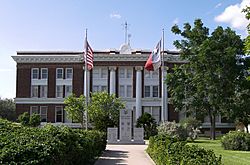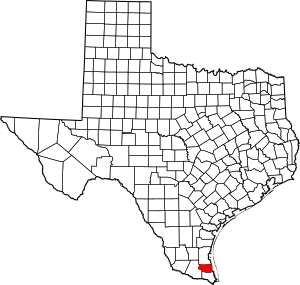Willacy County, Texas facts for kids
Quick facts for kids
Willacy County
|
|
|---|---|
|
County
|
|

The Willacy County Courthouse in Raymondville
|
|

Location within the U.S. state of Texas
|
|
 Texas's location within the U.S. |
|
| Country | |
| State | |
| Founded | 1912 |
| Named for | John G. Willacy |
| Seat | Raymondville |
| Largest city | Raymondville |
| Area | |
| • Total | 784 sq mi (2,030 km2) |
| • Land | 591 sq mi (1,530 km2) |
| • Water | 194 sq mi (500 km2) 25% |
| Population
(2020)
|
|
| • Total | 20,164 |
| • Density | 25.719/sq mi (9.930/km2) |
| Time zone | UTC−6 (Central) |
| • Summer (DST) | UTC−5 (CDT) |
| Congressional district | 34th |
Willacy County is a county in the U.S. state of Texas. In 2020, about 20,164 people lived there. Its main town, called the county seat, is Raymondville. The county was officially started in 1911 and organized in 1912.
Willacy County is part of the Raymondville area. This area is also included in the larger Rio Grande Valley region of Texas.
Contents
History of Willacy County
Willacy County was created in 1911. It was made from parts of Cameron and Hidalgo Counties. The county was named after John G. Willacy, who was a state senator.
At first, Kenedy County was part of Willacy County. But in 1921, Kenedy County separated. This happened because the ranchers in the northern part wanted to be separate from the new farmers in the southern part.
Farming and Oil in Willacy County
In 1912, a special type of Bermuda onion was brought to Willacy County. These onions grew very well. They slowly took over land that used to be for ranching. Onions became the most important crop for a long time. The town of Raymondville even had an annual Onion Festival.
In 1940, the first oil wells were dug in the Willamar Oil Field. Today, making oil is a big part of the local economy. Natural gas production is also becoming very important. In the 1940s, sorghum was also introduced. This crop slowly replaced cotton and other plants. Raising cattle is still a major economic activity in the county.
Wind Power Development
In the early 2010s, tall wind turbines started to appear. They were built in the rural areas east of U.S. Highway 77. More turbines were added in 2020. These turbines became a symbol for the county. You can see them from nearby Cameron and Hidalgo Counties. The power lines that carry electricity were also improved during this time.
Geography of Willacy County
Willacy County covers about 784 square miles. About 194 square miles of this area is covered by water. This means about 25% of the county is water. The county is located right next to the Gulf of Mexico.
Main Roads in Willacy County
Neighboring Counties
- Kenedy County (to the north)
- Cameron County (to the south)
- Hidalgo County (to the west)
Protected Natural Areas
- Laguna Atascosa National Wildlife Refuge (part of it is in Willacy County)
- Padre Island National Seashore (part of it is in Willacy County)
People of Willacy County
| Historical population | |||
|---|---|---|---|
| Census | Pop. | %± | |
| 1930 | 10,499 | — | |
| 1940 | 13,230 | 26.0% | |
| 1950 | 20,920 | 58.1% | |
| 1960 | 20,084 | −4.0% | |
| 1970 | 15,570 | −22.5% | |
| 1980 | 17,495 | 12.4% | |
| 1990 | 17,705 | 1.2% | |
| 2000 | 20,082 | 13.4% | |
| 2010 | 22,134 | 10.2% | |
| 2020 | 20,164 | −8.9% | |
| U.S. Decennial Census 1850–2010 2010 2020 |
|||
In 2010, there were 22,134 people living in Willacy County. There were 5,764 households and 4,607 families. About 46% of households had children under 18 years old. Many households were married couples living together.
Most people in Willacy County are of Hispanic or Latino background. In 2010, about 87.2% of residents were Hispanic or Latino. The county is known for having a large Hispanic population.
The average age of people in the county was 32 years old. About 26.8% of the population was under 18. About 11.7% of people were 65 or older.
The average income for a household in the county was $22,881. This means Willacy County is one of the poorest counties in the United States.
Education in Willacy County
Several school districts serve the children of Willacy County:
- Lasara Independent School District
- Lyford Consolidated Independent School District
- Raymondville Independent School District
- San Perlita Independent School District
Students can also apply to special magnet schools. These schools are run by the South Texas Independent School District. All parts of the county are also served by Texas Southmost College for higher education.
Media in Willacy County
Here are some local media outlets in Willacy County:
- Raymondville Chronicle & Willacy County News – Official Site: https://www.raymondville-chronicle.com/
- KFRQ 94.5FM – Official Site: http://www.q945rocks.com
- KKPS 99.5FM – Official Site
- KNVO 101.1FM – Official Site: http://www.romantica101.com
- KVLY 107.9FM – Official Site: http://www.mix1079.net
Prisons in Willacy County
Raymondville is home to three private prisons. They are all located next to each other:
- the Willacy County Correctional Center (closed in 2015)
- the Willacy County Regional Detention Center
- and Willacy County State Jail
Communities in Willacy County
Cities
- Lyford
- Raymondville (the county seat)
- San Perlita
Census-Designated Places
These are areas that are like towns but are not officially incorporated as cities.
Unincorporated Community
See also
 In Spanish: Condado de Willacy para niños
In Spanish: Condado de Willacy para niños

